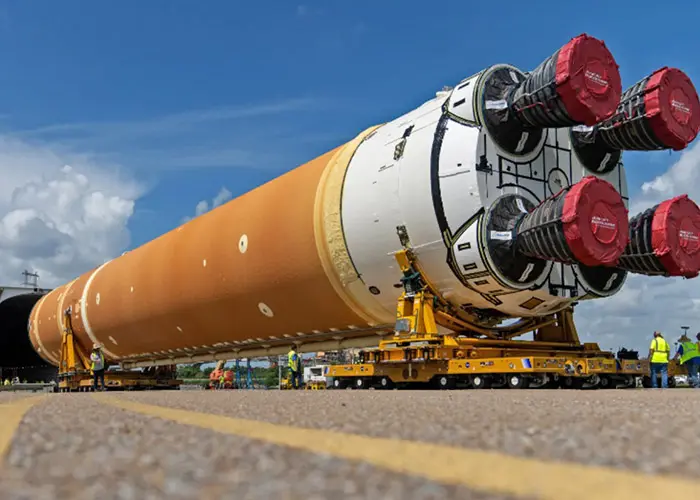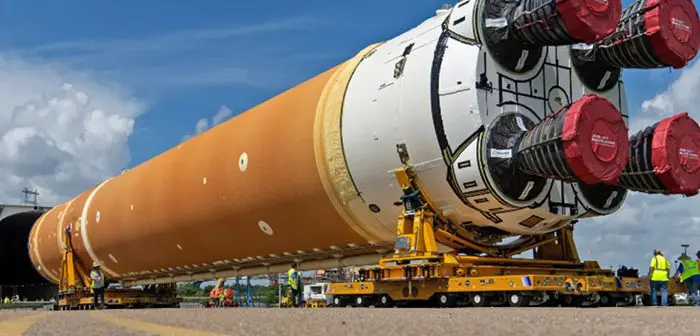
Move teams with NASA and Boeing have moved the core rocket stage for the Space Launch System (SLS) onto a barge for ferrying to the Kennedy Space Center, where it will be integrated with other parts of the rocket that will power NASA’s Artemis II mission.
NASA and Boeing, the SLS core stage lead contractor, gently transported the 212-foot core stage 2.1 kilometres from inside NASA’s Michoud Assembly Facility in New Orleans to the agency’s Pegasus barge on July 16, 2024. Once secured onto the barge, it will travel 1,450 kilometres to the launch site in Florida, where engineers will prepare it in the Vehicle Assembly Building for attachment to other rocket and Orion spacecraft elements.
The SLS rocket’s core stage is the largest NASA has ever produced. It consists of five major elements, including two propellant tanks that collectively hold more than 2,774,706 litres of super-chilled liquid propellant to feed four RS-25 engines. During launch and flight, the stage will operate for just over eight minutes, producing more than two million pounds of thrust – enough to propel four astronauts inside NASA’s Orion spacecraft toward the Moon.
“The delivery of the SLS core stage for Artemis II to Kennedy Space Center signals a shift from manufacturing to launch readiness as teams continue to make progress on hardware for all major elements for future SLS rockets,” said John Honeycutt, SLS program manager at NASA’s Marshall Space Flight Center.
After arriving at NASA Kennedy, the stage will undergo additional outfitting. Engineers will then join it with the segments that form the rocket’s twin solid rocket boosters. Adapters for the Moon rocket that connect it to the Orion spacecraft will be shipped to NASA Kennedy this Southern Hemisphere spring, while the interim cryogenic propulsion stage is already in Florida. Engineers continue to prepare Orion, already at Kennedy, and exploration ground systems for launch and flight, tentatively scheduled for September 2025.
All major structures for every SLS core stage are manufactured at NASA Michoud. Inside the factory, core stages and future exploration upper stages for the next evolution of SLS, called the Block 1B configuration, are currently in various phases of production for Artemis III, IV, and V. Beginning with Artemis III, to better optimise space at Michoud, Boeing, the SLS core stage prime contractor, will use space at NASA Kennedy for final assembly and outfitting activities.
Building, assembling, and transporting the SLS core stage is a collaborative effort for NASA, Boeing, and lead RS-25 engines contractor Aerojet Rocketdyne. All ten NASA centers contribute to its development, with more than 1,100 companies across the United States also having a hand in its production.
“With Artemis, we’ve set our sights on doing something big and incredibly complex,” said Associate Administrator for NASA’s Exploration Systems Development Mission Directorate, Catherine Koerner. “The SLS rocket is a key component of our efforts to develop a long-term presence at the Moon.”





